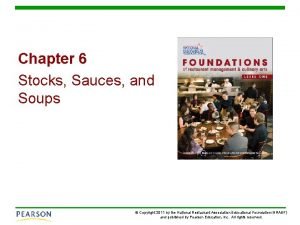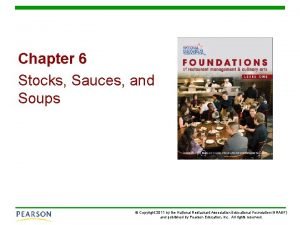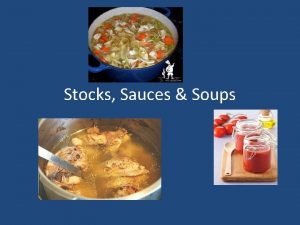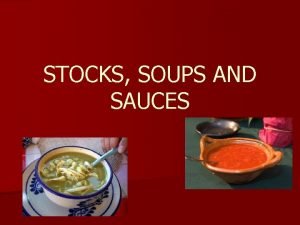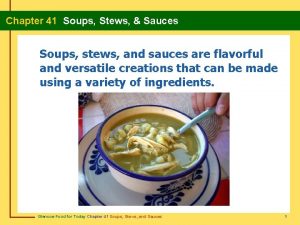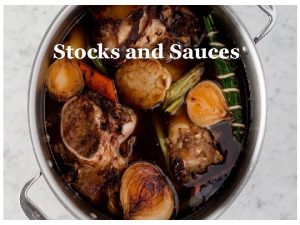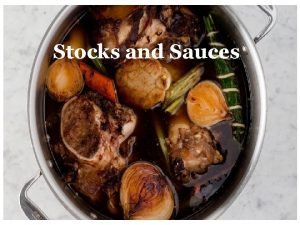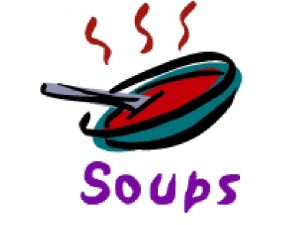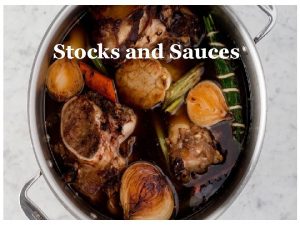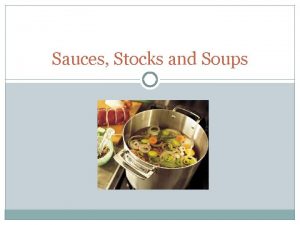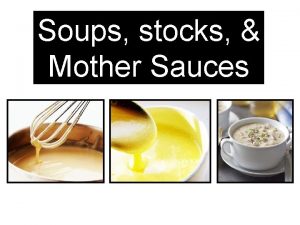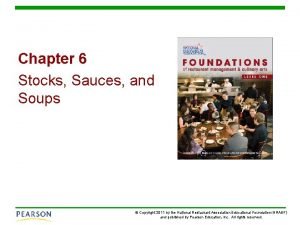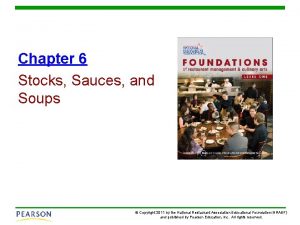Chapter 6 Stocks Sauces and Soups Copyright 2011














- Slides: 14

Chapter 6 Stocks, Sauces, and Soups © Copyright 2011 by the National Restaurant Association Educational Foundation (NRAEF) and published by Pearson Education, Inc. All rights reserved.

The Essential Parts of Stock § There are four essential parts to all stocks: § A major flavoring ingredient § A liquid, most often water § Mirepoix § Aromatics § Mirepoix: refers to the mixture of coarsely chopped onions (50%) carrots (25%) and celery (25%) that provide a flavor base for stock. § Aromatics: such as bouquet garni and sachet d’épices, are the herbs, spices, and flavorings that create a savory smell. 6. 1 Chapter 6 | Stocks, Sauces, and Soups 2

Types of Stocks A stock is a flavorful liquid made by gently simmering bones and/or vegetables. To use bones for stock, you must first cut them to the right size and then prepare them by blanching, browning, or sweating. 6. 1 Chapter 6 | Stocks, Sauces, and Soups 3

Types of stocks (cont. ) § White stock: clear, pale liquid § Brown stock: amber colored, uses browned bones § Fumet: made with fish bones § Court bouillon: made with aromatic vegetables § Glace: reduced stock with jelly-like consistency § Jus: rich stock used as a sauce for roasted meats § Vegetable stock: made with mirepoix, leeks, and turnips 4

Preparing Stocks § Blanching: rids them of some of the impurities that can cause cloudiness in a stock. § To brown bones, roast them in a (400°F) oven for about an hour, until they are golden brown. § Sweating causes bone and mirepoix to release flavor more quickly when liquid is added. § Cool stock to minimize the time the stock spends in the temperature danger zone (cool in an ice water bath) § Frozen stocks can be held for 3 months 6. 1 Chapter 6 | Stocks, Sauces, and Soups 5

Degreasing Stock Degreasing: process of removing fat that has cooled and hardened from the surface of the stock. § Degreasing also removes some of the fat content, making the stock more healthful. § Degrease stock by skimming, scraping, or lifting hard fat. 6. 1 Chapter 6 | Stocks, Sauces, and Soups 6

Grand Sauces A sauce is a liquid or semisolid product that is used in preparing other foods. § There are five classical grand sauces that are the basis for most other sauces: § Béchamel: milk and white roux § Espagnole sauce: brown stock and brown roux § Tomato sauce: stock and tomatoes § Hollandaise: an emulsion made from eggs, butter, and lemon. § Velouté: veal, chicken, or fish stock and a white roux Grand sauces are rarely used by themselves 6. 2 Chapter 6 | Stocks, Sauces, and Soups 7

Derivative sauces § Demi-glace: equal parts espagnole sauce and veal stock § Creole sauce: tomato sauce , onions, garlic, parsley § Bernaise and Maltaise: Hollandaise, Tarragon, white wine, vinegar

Basic Ingredients in Sauces A key ingredient in sauce is the thickener, which adds richness and body. § Roux: a thickener made of equal parts cooked flour and a fat (clarified butter, oil, or shortening) § Beurre manié: thickener made of equal parts flour and soft, whole butter. § slurry: cornstarch mixed with a cold liquid, can be used instead of roux. § Liaison: mixture of egg yolks and heavy cream, often used to finish some sauces. 6. 2 Chapter 6 | Stocks, Sauces, and Soups 9

Preparing Different Kinds of Sauces § Compound butter: mixture of butter and various flavoring ingredients (herbs, nuts, citrus zest, shallots, and vegetables) § Coulis: thick puréed sauce. § Salsa: cold mixture of fresh herbs, spices, fruits, and/ or vegetables. § Jus-lié: sauce made from the juices from cooked meat and brown stock. § Straining methods: 1. wringing method (with cheesecloth) 2. China cap or chinois 6. 2 Chapter 6 | Stocks, Sauces, and Soups 10

Basic Kinds of Soup There are two basic kinds of soup—clear soups and thick soups. § Clear soups include: 1. flavored stocks/broth (water, vegetables, bones, mirepoix, bouquet garni) 2. consommés (rich, flavorful stock that is clarified) 3. chicken noodle soup 4. minestrone 6. 3 Chapter 6 | Stocks, Sauces, and Soups 11

Thick soups § Thick soups include: 1. cream soups: smooth soup; thickened with a roux; never boil 2. purée soups: thickened by the starch found in the pureed main ingredient (potatoes) 3. bisques: pureed shellfish shells and vegetables then strained resulting in grainy texture 4. chowders: hearty thick soup; thickened with roux

Basic soups § There are many variations of these basic soups: § Fruit soups (Gazpacho, a savory tomato soup) § Cold soups (Borscht, a beet soup) § Traditional regional soups (New England chowder, gumbo)

Preparing Soups § Most soups are cooked at a gentle simmer and stirred occasionally. § Soups should also be garnished just before service. 6. 3 Chapter 6 | Stocks, Sauces, and Soups 14
 Chapter 6 stocks sauces and soups
Chapter 6 stocks sauces and soups Chapter 6 stocks sauces and soups
Chapter 6 stocks sauces and soups Chapter 6 stocks sauces and soups
Chapter 6 stocks sauces and soups Chapter 6 stocks sauces and soups
Chapter 6 stocks sauces and soups Siteserve
Siteserve Characteristics of starch
Characteristics of starch Stocks and sauces
Stocks and sauces What are the 6 mother sauces
What are the 6 mother sauces Four essential parts of a stock
Four essential parts of a stock What do soups stews and sauces have in common
What do soups stews and sauces have in common Brown beef stock appearance and presentation
Brown beef stock appearance and presentation Stocks and sauces
Stocks and sauces Classification of thickening agents
Classification of thickening agents Classification of soups
Classification of soups Dr david echevarria
Dr david echevarria

